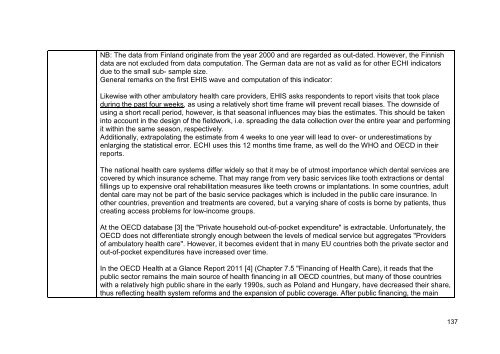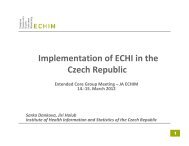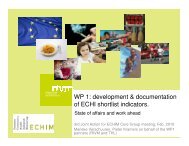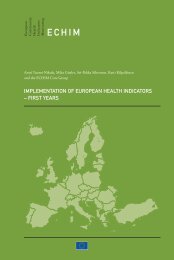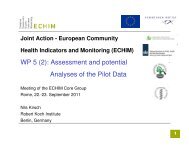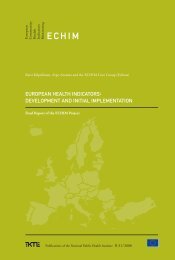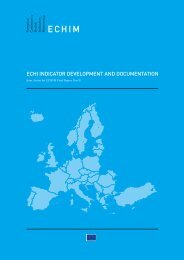Final Report Part III ECHIM Pilot Data Collection Analyses and Dissemination
Part III: ECHIM Pilot Data Collection, Analyses and Dissemination
Part III: ECHIM Pilot Data Collection, Analyses and Dissemination
- No tags were found...
You also want an ePaper? Increase the reach of your titles
YUMPU automatically turns print PDFs into web optimized ePapers that Google loves.
NB: The data from Finl<strong>and</strong> originate from the year 2000 <strong>and</strong> are regarded as out-dated. However, the Finnish<br />
data are not excluded from data computation. The German data are not as valid as for other ECHI indicators<br />
due to the small sub- sample size.<br />
General remarks on the first EHIS wave <strong>and</strong> computation of this indicator:<br />
Likewise with other ambulatory health care providers, EHIS asks respondents to report visits that took place<br />
during the past four weeks, as using a relatively short time frame will prevent recall biases. The downside of<br />
using a short recall period, however, is that seasonal influences may bias the estimates. This should be taken<br />
into account in the design of the fieldwork, i.e. spreading the data collection over the entire year <strong>and</strong> performing<br />
it within the same season, respectively.<br />
Additionally, extrapolating the estimate from 4 weeks to one year will lead to over- or underestimations by<br />
enlarging the statistical error. ECHI uses this 12 months time frame, as well do the WHO <strong>and</strong> OECD in their<br />
reports.<br />
The national health care systems differ widely so that it may be of utmost importance which dental services are<br />
covered by which insurance scheme. That may range from very basic services like tooth extractions or dental<br />
fillings up to expensive oral rehabilitation measures like teeth crowns or implantations. In some countries, adult<br />
dental care may not be part of the basic service packages which is included in the public care insurance. In<br />
other countries, prevention <strong>and</strong> treatments are covered, but a varying share of costs is borne by patients, thus<br />
creating access problems for low-income groups.<br />
At the OECD database [3] the "Private household out-of-pocket expenditure" is extractable. Unfortunately, the<br />
OECD does not differentiate strongly enough between the levels of medical service but aggregates "Providers<br />
of ambulatory health care". However, it becomes evident that in many EU countries both the private sector <strong>and</strong><br />
out-of-pocket expenditures have increased over time.<br />
In the OECD Health at a Glance <strong>Report</strong> 2011 [4] (Chapter 7.5 "Financing of Health Care), it reads that the<br />
public sector remains the main source of health financing in all OECD countries, but many of those countries<br />
with a relatively high public share in the early 1990s, such as Pol<strong>and</strong> <strong>and</strong> Hungary, have decreased their share,<br />
thus reflecting health system reforms <strong>and</strong> the expansion of public coverage. After public financing, the main<br />
137


